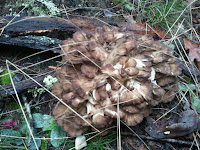
Back in 2001, I was disappointed to see elementary kids sending pickup truck loads of seeds off to the state nurseries without keeping any to grow themselves. Most teachers will tell you however, any tree planted on school grounds is vulnerable. Even in urban areas, rodents, rabbits and deer can wipe out a class project overnight. And well-meaning custodians sometimes get carried away with their weed-whackers and mowers.
So in 2006 I called the very nice folks at the Potomac Conservancy who ran the Growing Native program and told them about my strategies for growing trees inside classrooms. We held some teacher workshops over the next few years and now many schools have Grow-Out Stations. The slides from one of those workshops are still available on the
Growing Native website and at
TreesInSchools.org.or
ChestnutsInSchools.org.
There's not much to it. I collected more than 40 old recycling bins when Arlington County Virginia distributed larger bins, and gave most away to teachers. You can find similar size bins anywhere, often for just a few dollars. I continue witht he recycling theme by using corn-based plastic cups from my morning iced coffees, or from ubiquitous Big Gulp cups for individual planters within the larger bins.
Most tree seeds require cold stratification of 60 days or longer to germinate, easily simulated in a refrigerator. Some also require scarification to weaken the seed coat that allows the embryo to break free. Others, like white oaks, will germinate almost as soon as they hit the ground. You can use natural soil if it's loamy, but clay will harden, crack, and fail the plant. Otherwise, consider potting mixes.
The most important step, particularly if you decide to keep the bins outside, is to protect the seeds from squirrels. It may not be an exaggeration to say they're watching you while you plant these seeds. If inside, the major threat seems to be from kids overwatering the young seedlings.
 I took a few photos during our walk as the fog lifted this morning. Little arachnids encased these thistles with webs, and I liked how they stood out from the backdrop of the cliffs across the river.
I took a few photos during our walk as the fog lifted this morning. Little arachnids encased these thistles with webs, and I liked how they stood out from the backdrop of the cliffs across the river.













